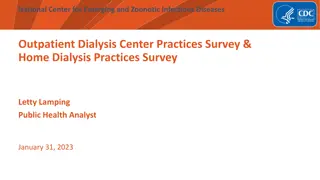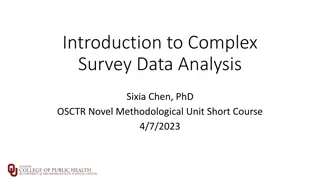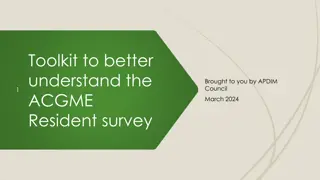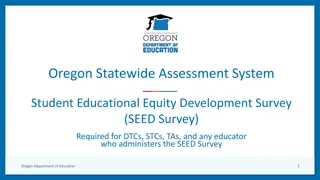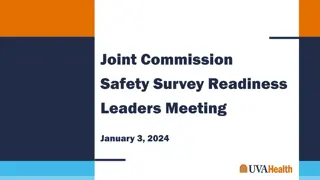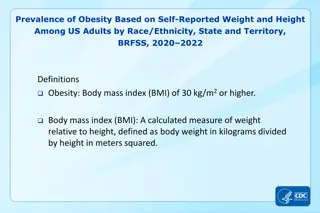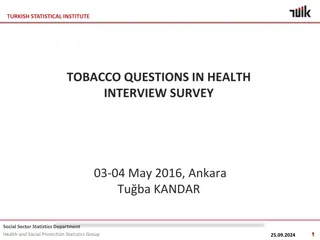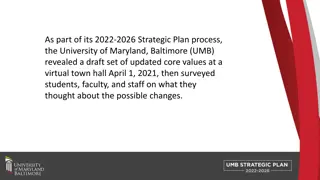Overview of BRFSS Survey and its Core Components
The Behavioral Risk Factor Surveillance System (BRFSS) is a state-based telephone survey that monitors personal health behaviors in non-institutionalized adults. It collaborates with the CDC and all 50 U.S. states to gather data on various health topics. The survey includes fixed core questions on demographics, general measures, risk behaviors, and chronic health conditions. Optional modules cover specialized topics, and rotating core questions change biennially. Emerging core areas address timely health issues like vaccine shortages and e-cigarette use.
Download Presentation

Please find below an Image/Link to download the presentation.
The content on the website is provided AS IS for your information and personal use only. It may not be sold, licensed, or shared on other websites without obtaining consent from the author.If you encounter any issues during the download, it is possible that the publisher has removed the file from their server.
You are allowed to download the files provided on this website for personal or commercial use, subject to the condition that they are used lawfully. All files are the property of their respective owners.
The content on the website is provided AS IS for your information and personal use only. It may not be sold, licensed, or shared on other websites without obtaining consent from the author.
E N D
Presentation Transcript
Vanessa Miguelino-Keasling, MPH Chronic Disease Surveillance & Research Branch
Overview of BRFSS Survey Background and purpose of BRFSS BRFSS survey content and data availability Uses of and access to BRFSS data
What is BRFSS? Behavioral Risk Factor Surveillance System State-based, cross sectional, random-digit- dialed telephone survey conducted annually Non-institutionalized adults aged > 18 years Monitors personal health behaviors that put health at risk Collaboration between CDC and 50 US States/Territories California participation since 1984
CANCER SCREENING DIET/OBESITY CHRONIC HEALTH CONDITIONS TOBACCO USE HEALTH CARE ACCESS ORAL HEALTH ALCOHOL USE BRFSS WOMEN S HEALTH HEALTH-RELATED QUALITY OF LIFE DISABILITY DIABETES OTHER TOPICS/ OPTIONAL MODULES IMMUNIZATION 3
Survey Content Core questions Asked by all states (fixed/rotating/emerging) Optional modules Specialized topic questions states can choose to include State-added questions State program specific questions to address state local, and program-specific needs
Fixed Core Demographics (age, race/ethnicity, education level, marital status, height/weight, employment, etc.) General Measures (health status, health care access, disability, health-related quality of life, etc.) Risk Behaviors (tobacco use, alcohol use, immunization, HIV/AIDS, seatbelt use, etc.) Chronic Health Conditions/Screening (diabetes, asthma, cardiovascular disease, depressive disorder, etc.)
Rotating Core Odd Years Hypertension Awareness Cholesterol Awareness Arthritis Burden Fruits & Vegetables Physical Activity Even Years Oral Health Falls Inadequate Sleep Drinking and Driving Breast & Cervical Cancer Screening Prostate Cancer Screening Colorectal Cancer Screening
Emerging Core Influenza vaccine shortage 2004-2005 H1N1 flu vaccinations 2009 Health care access 2013 E-Cigarettes use 2016
Optional Modules Caregiver Module Cognitive Decline Module Human Papillomavirus (HPV) vaccination Industry and Occupation Breast and Cervical Cancer Screening Cancer Survivorship Sexual Orientation and Gender Identity Emotional Support and Life Satisfaction Childhood Asthma Prevalence Excess Sun Exposure
State/Program Participants California Tobacco Control Program California Comprehensive Cancer Control Program Safe and Active Communities Branch Office of Disability and Health Immunization Branch Nutrition Education and Obesity Program Childhood Lead Poisoning Branch Environmental Health Investigations Branch California Heart Disease and Stroke Prevention California Arthritis Partnership Program
Survey Structure BRFSS core (~90) Optional modules (~20-30) State/program- added questions (~50 75) Track 1 BRFSS core (~90) Optional modules (~20-30) State/program- added questions (~50-75) Track 2 BRFSS core (~90) California Adult Tobacco Survey (CATS) (~100+) Optional modules (~20-30) Track 3
Survey Development National BRFSS survey Annual BRFSS Conference Proposals and Workgroups Presentations and Discussions Tallying votes CA BRFSS survey Quarterly Data Users Meetings State/Program-added Questions Proposals Questionnaire Development
Survey Timeline Draft survey reviewed at Quarterly Data Users Meeting _ October Survey planning, cost per question determined July Pre- State- added questions proposals September Data collection begins _ January testing/pro gramming of state- added questions Oct Dec Survey instrument finalized December
Who uses BRFSS? State and Local Health Departments Students and Researchers Federal Agencies Non-profit Agencies Research organizations Media
How is BRFSS data used? Assess health needs and monitor trends of personal behaviors of the population Plan, implement, and evaluate public health strategies Monitor and respond to public health emergencies Identify health disparities Prepare grant proposals Publish and distribute fact sheets, reports, and peer-reviewed scientific manuscripts
Access to CA BRFSS Public Health Survey Research www.csus.edu/research/phsrp Program (PHSRP) www.csus.edu/research/phsrp Data sharing agreement/ data request form (PHSRP@csus.edu) PHSRP@csus.edu Download data via secure link
Access to BRFSS http://www.cdc.gov/brfss/ CDC BRFSS: http://www.cdc.gov/brfss/ Aggregated data from all 50 states and participating territories Download data files, code book, design documents, methodology, surveillance summaries, fact sheets, newsletters, etc. Access to questionnaires, lists of optional modules used by states, and state-added questions. Prevalence and Trends Data, BRFSS Interactive Maps (GIS), Web Enabled Analysis Tool (WEAT) SMART City and County Survey Data
Further Information Contact: Sandy.Kwong@cdph.ca.gov Sandy.Kwong@cdph.ca.gov CA BRFSS Coordinator






